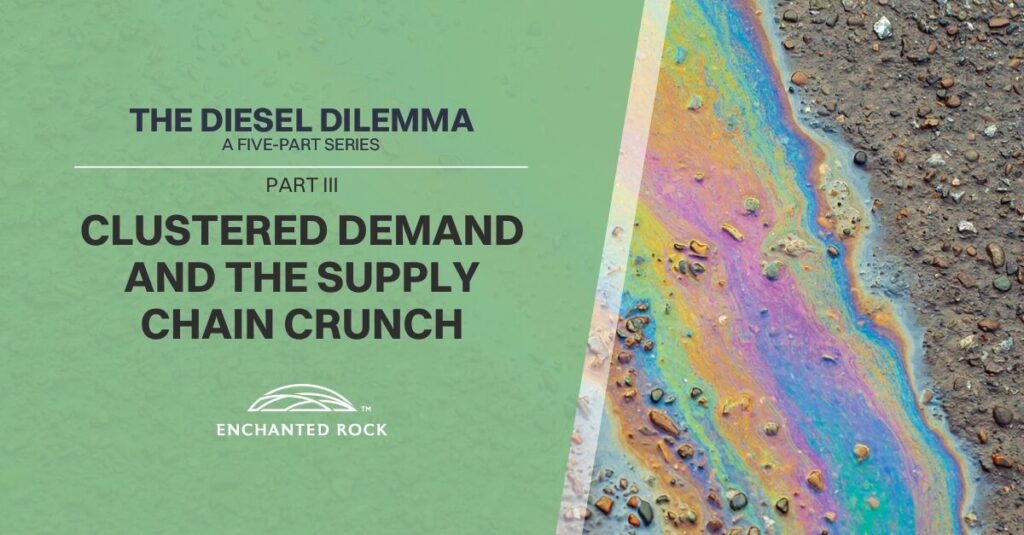[datacenter_tag_image]


Clustered Demand and the Supply Chain Crunch
This five-part series explores the operational characteristics of diesel fuel, which is the most common form of industrial-scale backup generation. With the rapid rise of AI-driven data centers, the series will examine how conventional backup practices need to adapt to meet the industry’s growing demand for resiliency and performance.
The third installment covers the regional supply chain for diesel fuel and how a sudden rise in demand during an outage can bring fuel deliveries to a standstill.
As explained in the previous Diesel Dilemma article, the “truck math” it takes to power diesel backup for a 500 MW data center is tricky enough on its own and practically impossible to manage even when the weather cooperates. Diesel backup gets significantly more complex when you look beyond your facility’s gate and into the regional supply chain. Even if your site can handle 200+ truck deliveries in a short resupply window, the question becomes: can your suppliers secure the diesel fuel you need?
Diesel supply issues can’t outrun regional demand
Most large-load data center markets are built in clusters called Availability Zones to reduce latency between facilities, lowering overall costs and improving customer experience. As a result, data center markets like Northern Virginia, Dallas–Fort Worth, Phoenix, and other hotspots have packed dozens of massive facilities into the same fuel distribution market. So, when a major storm, regional blackout, or grid power supply disruption hits those regions, every one of those facilities is making the same phone call to the same fuel terminals at the same time – “We need diesel fuel delivered ASAP.”
And it’s not just data centers. Hospitals, water treatment plants, emergency response bases, and municipal services are also grabbing their places in that queue. The result? In just a matter of hours, local diesel terminals and pipelines can hit demand levels that are far beyond their designed capacity.
The diesel supply crunch extends beyond your site
Fuel terminals have finite truck-loading racks, and each rack serves one truck at a time, with typical loading cycles of 10–20 minutes. If a terminal can load 4–6 trucks an hour, that’s their ceiling, no matter how many trucks are waiting outside the gate. Rising demand from clustered sites can quickly saturate this limited throughput, creating long backlogs. Terminals also cap individual allocations to conserve supply, further restricting deliveries during peak demand.
Now imagine if the same outage affects power to the fuel terminal. The facility’s pipeline feeds, storage tanks, and loading rates will slow to a crawl, or even worse, stop entirely.
The ripple effect of competing demand
Even when the fuel is there, you, as a data center or other non-critical facility, are most likely not at the top of the list for delivery. Emergency response agencies, hospitals, and critical public infrastructure often receive priority allocation during disasters. And while data centers are essential to the digital economy, they aren’t the first in line when fuel is scarce during an extended power outage, regardless of how many fuel supplier contracts you have.
This supply chain crunch doesn’t just delay deliveries; it compounds the previously discussed “truck math” problem. Now you’re only getting half of those 219 trucks you needed to deliver 1.75 M gallons of diesel in two days for your 500 MW data center. Your outage protection window begins to collapse. If the outage drags on, you’re in a race against every other facility in your region for the same shrinking pool of available trucks and gallons of diesel fuel. And attempting to source diesel from out of state during a long-duration outage is unlikely to succeed, as the disruption has already made it nearly impossible to move fuel into the region.
Pipeline vs. trucks: Rethinking diesel for critical operations
The supply chain crunch is one of the most dangerous blind spots for diesel backup systems, even when you plan your site logistics down to the minute. If the regional infrastructure can’t support clustered high demand during an outage, your plan, and most importantly your facility’s operations, will fail.
In contrast to those diesel dynamics, natural gas systems aren’t reliant on fuel delivery via tanker trucks, and natural gas doesn’t compete for limited terminal loading slots. Underground pipeline delivery means natural gas can sustain prolonged, high-load operation without needing a convoy of trucks. Pipelines supply natural gas continuously with built-in redundancy, ensuring flow even if local segments are disrupted. This makes natural gas supply inherently more scalable and reliable than truck-dependent diesel, especially for long-duration, high-load outage events.
Backup plans must be reliable, not a risk
When extended outages strike, the trucks and terminals that support the regional supply chain for diesel fuel introduce added risks, precisely when resiliency matters most for a critical operation. Storing large volumes of diesel onsite also raises costs because the fuel requires regular testing, treatment, and equipment upkeep to prevent degradation and ensure reliability, not to mention the additional dedicated land and permitting requirements. And when you add in competing demand during outages, no amount of onsite planning can offset the vulnerabilities of the diesel supply chain.
For data centers and other power-intensive operators facing rising power needs, the choice between truck-based logistics and pipeline-based assurance is the difference between fragility and resilience. And in the end, diesel isn’t backup power; it’s just a backup plan waiting to fail.
Next up: Site Logistics & Security: How tank farms, truck staging, and refueling create operational and safety headaches.
This article was originally published on LinkedIn.